Last autumn the Arnold Arboretum launched the Campaign for the Living Collections, an ambitious ten-year plan to expand the breadth of plant holdings and increase their scientific and horticultural value. Considerable thought and effort went into creating a document that guides the Campaign’s mission. We present this important document here in its entirety for the benefit of Arboretum supporters, stakeholders, and colleagues. Additional articles covering aspects of developing our Living Collections will be featured in Arnoldia this year.
The Living Collections of the Arnold Arboretum of Harvard University not only support the Arboretum’s mission by serving key research, education, and conservation roles, but in their entirety represent one of the very best examples of a historic Olmsted landscape. With some 15,000 accessioned plants, representing almost 4,000 unique taxa that include 2,100 species, the Living Collections of the Arnold Arboretum remain a major destination for those who study and enjoy woody plants. Of the accessions brought to the Arboretum from elsewhere, 44% are of wild origin, hailing from over 60 different temperate countries. Another 39% are of cultivated origin, including pedigreed hybrids, nursery-origin introductions, and accessions from other gardens. This historic interplay between taxonomic, floristic, and cultivated diversities has resulted in one of the most comprehensive and heavily documented collections of temperate woody plants in the world.
The living collections are central to the Arnold Arboretum—all research, education, and conservation initiatives are driven by them. And yet, without strategic planning for collections development, these collections are at risk of losing their prominence. In advance of the Arboretum’s sesquicentennial in 2022, it is time to put forward a set of initiatives to simultaneously preserve its singular legacy and secure its future. This plan, to be enacted over the next decade, will thus serve to shape and define the Living Collections of the Arnold Arboretum for the coming century.
Values and Aspirations
Throughout the Arboretum’s history, the vitality and strength of the collections—and the institution as a whole—can be attributed to an adherence to four essential tenets. It has remained a traditional arboretum, with the Living Collections continually and almost exclusively focused on temperate woody plants. It has been committed to collections-based woody plant scholarship, particularly in recent years with the significant expansion of on-site research associated with construction of the Weld Hill Research Building. The Arboretum landscape remains true to the vision of Frederick Law Olmsted’s design, through keen awareness of its role as a public garden and landscape. Lastly, the Arnold Arboretum has long invested in active curation and collections management, which in turn has fostered and enabled its research and preservation enterprises.
Coupled to these principles are aspirations that the Living Collections Advisory Board (Tim Boland, David Boufford, Michael Donoghue, Larry Hufford, Paul Meyer, and Don Pfister), in collaboration with William (Ned) Friedman (Director), Michael Dosmann (Curator of Living Collections), and Andrew Gapinski (Manager of Horticulture), advanced during its 2013, 2014, and 2015 meetings. These recommendations to ambitiously strengthen the collections of the Arnold Arboretum articulate a set of guidelines that define targets for active collections development. In addition, these recommendations clearly circumscribe overarching principles that will help ensure that the Arnold Arboretum remains at the leading edge of botanical garden collections development.
Enacting the Agenda and Creating a List of Desiderata
Four principles will shape a unique identity for the Arboretum’s ongoing and future roles in collections-based research, teaching, and public horticulture: (1) scholarship associated with comparative biology, from genomics to environmental change; (2) ex situ conservation and study of endangered temperate woody plant taxa; (3) strengthened species representation within key priority genera; and (4) successful cultivation of taxa currently or historically perceived as marginally hardy in Boston. Shared among these is the primary importance of a university-based organismic collection and public garden with the potential to uniquely reveal the complexities of nature. This deeply held notion expresses the intrinsic value that an individual accession or a suite of accessions possesses that enables a scholar to unravel (and share with the world) a taxon’s mysteries. This extends to naturally occurring taxa as well as unique cultigens, honoring the Arboretum’s long history of cultivating and comparing both, side-by-side. This core philosophy underpins all others.
In support of these priorities for collections development, six goals have been used to specifically create and prioritize a list of desiderata for acquisition and accessioning into the organismic collections of the Arnold Arboretum over the next decade (see page 15). These six goals reflect the importance of phylogenetic knowledge, organismic biology, conservation biology, genomics, and horticultural leadership to the future of the Arnold Arboretum.
1. Increase “phylogenetic breadth” within clades
The Arnold Arboretum will acquire new taxa that significantly expand the phylogenetic diversity of specific clades (evolutionary lineages). The modern explosion of phylogenetic information provides a key set of opportunities to ensure that the Arboretum acquires new taxa representative of as many of the major subclades of a genus or family as is practicable. Key families and genera that may be well represented in the Living Collections, as measured by total species numbers, may, in fact, lack critical exemplar species central to phylogenetic and comparative studies. This principle not only maximizes the potential for comparative evolutionarily grounded studies within and among diverse groups, but also serves as an organizing scheme for prioritized assembly of a synoptic collection.
2. Increase “biological breadth” within clades
The Arnold Arboretum will acquire new taxa that significantly expand the biological diversity of specific clades. These include key additions of taxa with strongly divergent phenologies, structure (habit, morphology, anatomy), or physiological traits associated with adaptation to environments that differ from other members of a clade, such as evergreen taxa in clades historically represented only by deciduous taxa (or vice versa). Attention to biological (and phylogenetic) breadth will significantly improve scholarship opportunities associated with comparative research endeavors within a single botanical collection and expand the public’s understanding of botanical and horticultural diversity within key genera and families of plants.
3. Create a unique identity in conservation biology
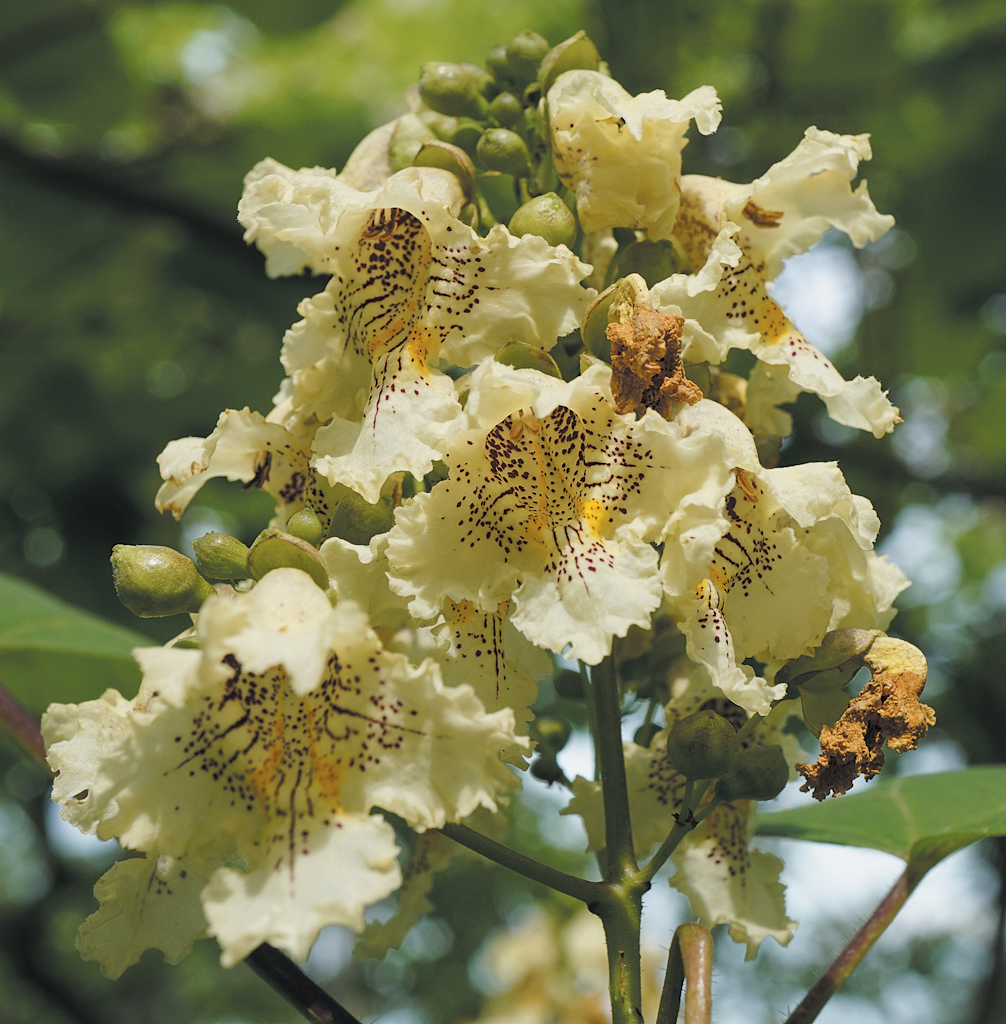

With continued threats to Earth’s biodiversity, the need to provide safe harbor to taxa under threat of extinction is as important today as it has ever been. However, while seed banks and other germplasm repositories may well preserve threatened and extinct-in-the-wild taxa, only living accessions of such taxa can be studied to reveal the biology within. The Arnold Arboretum is uniquely suited to acquire threatened temperate woody plants, cultivate them, develop essential propagation protocols, disseminate them to others, and conduct research into their basic biology. Beyond the innate value of generating new knowledge of biodiversity, effective ecological restoration depends on a sophisticated understanding of the basic and applied biology of threatened taxa.
4. Create a unique identity in woody plant genomics
For centuries, type specimens (pressed and dried plant parts) associated with the specific living organism on which a species description was first made have been deposited in herbaria around the world. In the emerging age of genomics, the Arnold Arboretum will become the first botanical garden to officially steward the living germplasm of diverse species for which detailed genomic information has been collected and published (the Arboretum will obviously focus only on temperate woody plants). Already, some of the key germplasm for genomic analysis of woody plants has been lost in the wild and exists only in tissue culture or short-term nursery operations, where biological study is not possible. Creating a “living type specimen collection” for species whose genomes have been sequenced and assembled will ensure that all future studies of the biology of such species will have access to the actual plant/germplasm with the specific allelic complement in the published genome.
5. Prioritize acquisition of taxa within geographically disjunct clades
Within the Living Collections of the Arnold Arboretum, the floras of eastern North America and eastern Asia have long been extremely well represented. Yet, to maximize the Living Collections’ further application toward the study of biogeography, ecophysiology, and phylogenetics, acquiring disjunct species associated with clades of eastern North American woody plants will be a priority. Although the majority of these disjunct taxa are of Asian origin, disjunct taxa from Europe and the Southern Hemisphere (although fewer in number) will also be sought.
6. Reassert horticultural leadership in accessioning marginally hardy species
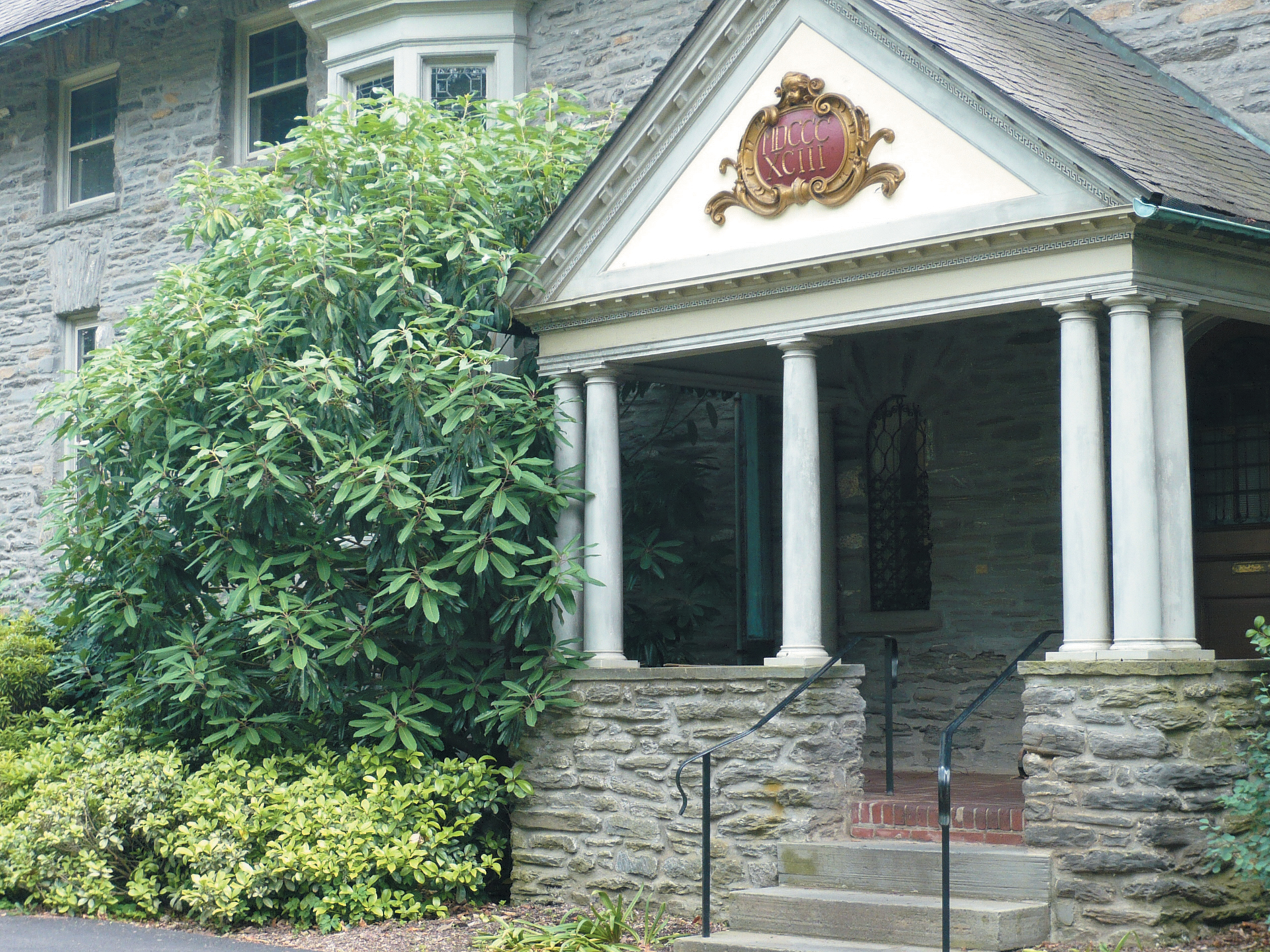

As established at its founding in 1872, the Arboretum will cultivate “all the trees, shrubs, and herbaceous plants, either indigenous or exotic, which can be raised in the open air.” In the spirit of exploration and experimentation, the Arboretum has continually acquired germplasm of marginally hardy taxa to be coaxed into cultivation, despite and against all odds. To ensure that the Arboretum stays at the cutting edge of plant introduction (especially in a world of rapid environmental change), it must seek out, acquire, and test untried species for growth on the grounds. Importantly, identification of new “marginal” taxa should be coupled with targeted field collections of germplasm from parts of the taxon’s natural range that are likely to predispose such accessions to ultimate success on the grounds. In light of predicted climate change scenarios over the next century in Massachusetts, the marginally hardy taxa of today are likely to be well positioned to grow and thrive at the Arnold Arboretum in the future.
With all of this in mind, a list of desiderata comprising roughly 400 separate taxa has been developed, where each target for acquisition falls into one and often multiple prioritized categories or themes based on the guiding principles above (Table 1). With this target list, the immediate goal is to obtain one new lineage of each taxon. However, in the longer term most targeted taxa will require multiple acquisitions from varying parts of their ranges to ensure broad genetic representation. All taxa on the list are to come from documented wild populations. This will result in as many as 700 unique acquisitions and eventually some 2,500 accessioned plants (assuming all new marginally hardy taxa survive on the grounds). The individuals on the list represent taxa that the Arboretum has never attempted to grow, those attempted in the past yet worthy of further efforts (especially in light of climate change and a far more sophisticated understanding of the microclimates of the Arboretum grounds), as well as those represented yet insufficiently. It should also be noted that this list of desiderata reflects, almost exclusively, botanical taxa. In time, attention should be placed on prudent review and development within cultivar collections. Importantly, the listed taxa represent specific priorities, not a limited scope for all future acquisitions.
Acquisition of New Plant Material and an Underlying Collaborative Philosophy
The aspirations of this plan to develop an exemplary collection at the Arnold Arboretum of Harvard University require a disciplined commitment to actuate collections expeditions, work with scholars in the field who can collect on behalf of the Arboretum, and employ contract collectors as needed. In particular, the Arnold Arboretum will leverage the deep and historical relationships with China, Japan, and Korea to mount a series of collecting expeditions to acquire new species and extend population sampling of currently held taxa. In turn, the leadership in propagation and horticultural operations at the Arnold Arboretum will be charged with bringing the world’s temperate woody flora from propagules to century-long inhabitants on the grounds. The current assemblage of what may prove to be the finest team of horticultural leaders in the Arboretum’s history provides strong motivation to seek out woody taxa from around the world that are not currently in cultivation at the Arboretum.
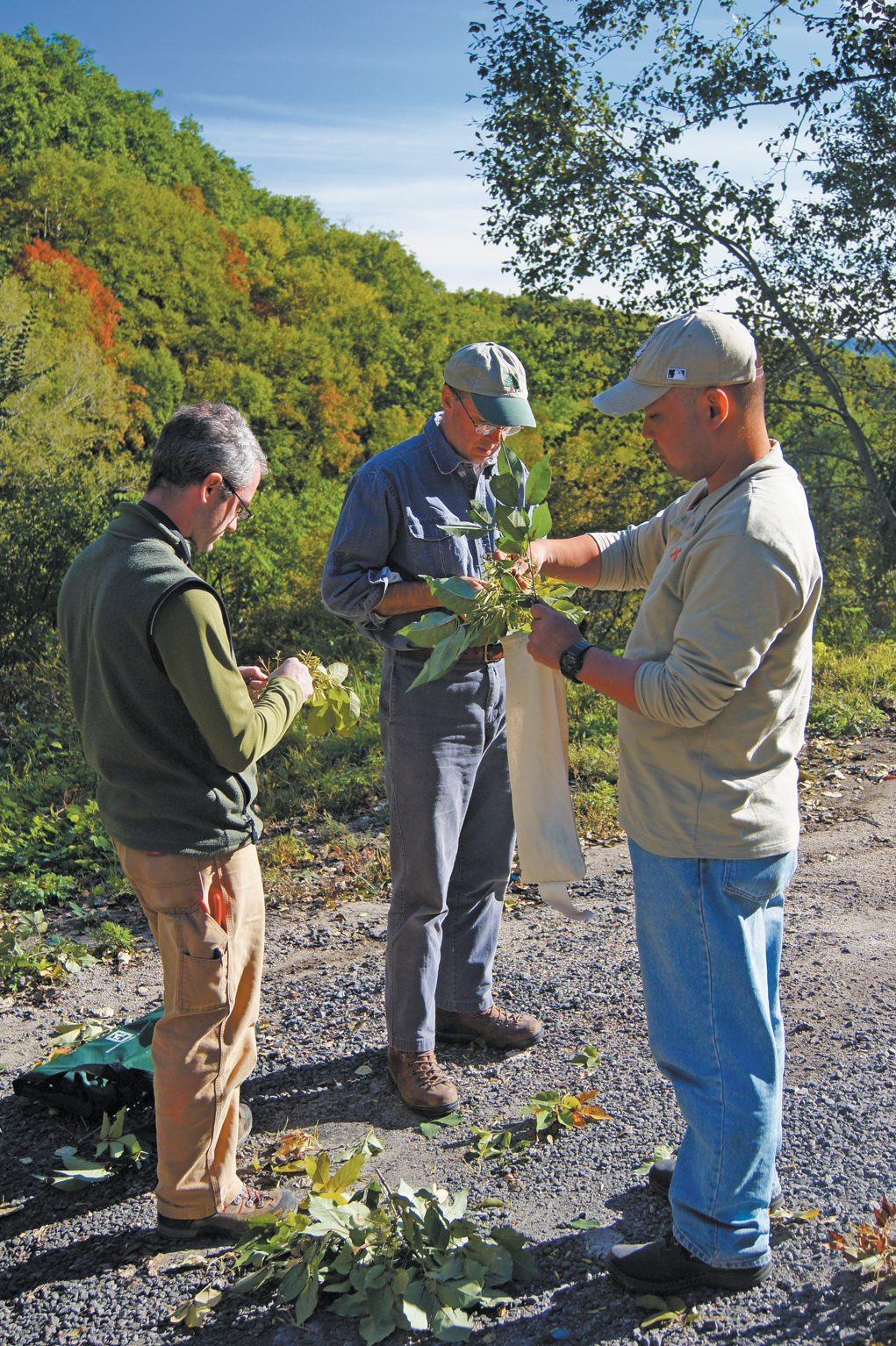

Central to the mission of acquiring hundreds of new specimens for the living museum and grounds of the Arnold Arboretum is a historical commitment to collaboration and sharing. Such collaborations are two-fold in nature. First, there is the need to establish joint ventures between the Arnold Arboretum and botanical and horticultural institutions around the world to collect germplasm. This is especially critical in Asia, where local and national permissions will depend on true cooperation, sharing, and reciprocity. Second, it will be vitally important to work with a set of similar institutions and consortia (e.g., the North America-China Plant Exploration Consortium) that can help steward newly acquired plant materials and ultimately share these acquisitions with scientists and the public. Such sharing of germplasm with similar institutions in the United States will be particularly important to maximize the success of ex situ conservation efforts, given that many of the taxa collected may be marginally hardy in Boston.
| Table 1. High-priority targets for future acquisition comprise 395 separate taxa that represent 385 species among 145 distinct genera (see List of Desiderata). Each distinct target is linked to one or more of the priority goals put forward by the Collections Advisory Board. This table summarizes those core themes and other basic statistics. |
| New species for the collections…….177 |
| —marginally hardy…………………………….92 |
| New genera for the collections…….41 |
| —marginally hardy…………………………….31 |
| Taxa already represented in the collection by living lineages…..218 |
| —but not of wild provenance………97 |
| —of wild provenance but requiring additional wild lineagesz………121 |
| Principal categoriesy: |
| Conservation concernx…………………51 |
| PCN genera…………………………………………..114 |
| Robust genera……………………………………12 |
| Disjunct genera…………………………….47 |
| Acquisition targets’ regions of origin: |
| Eastern Asia…………………………………..225 |
| Eurasia……………………………………………….18 |
| Europe………………………………………………..17 |
| North America……………………………..133 |
| South America………………………………..2 |
| z Includes taxa where numerous wild-origin lineages are required, often for conservation purposes, or to repatriate known Arboretum lineages from other repositories and gardens. y Categories are not mutually exclusive; many target species occur in multiple categories. x Those taxa to which a conservation ranking has been given. W Plant Collections Network: Acer, Carya, Fagus, Stewartia, Syringa, and Tsuga v Carpinus, Forsythia, Ginkgo, and Ostrya u Only pertains to species occurring in Cornus, Diervilla/Weigela, Hamamelis, Hydrangea, Magnolia, Taxus, and Viburnum |
In summary, integrating the core values that have yielded the Arboretum’s greatest legacy with six bold aspirational concepts will extend the importance and impact of the Arboretum’s organismic collections well into the future. Change in the Living Collections occurs incrementally over time, with each new accession added, and with each deaccession as well. As seasons turn into years, and years into decades, the ambitions and goals the Arboretum establishes now will truly bear fruit. At its bicentennial in 2072, the Arboretum community will be able to look back and pinpoint this campaign as one that guaranteed and secured a future where the Arnold Arboretum became the single most important living collection for those who study and enjoy temperate woody plants.
Developing an Exemplary Collection—Metrics and a List of Desiderata
Over the past decade, the total number of deaccessions has significantly exceeded the total number of new accessions planted at the Arnold Arboretum. On average each year, roughly 250 new accessions are successfully added to the collections. In order to achieve the goals described in this plan to secure the long term preeminence of the Living Collections of the Arnold Arboretum, acquisition and successful propagation of new and diverse germplasm will dominate the early phases of this campaign. The second phase of this ambitious program will then leverage the accomplishments of plant production efforts to move new accessions onto the grounds. We anticipate that at the peak of this second phase close to 300 new accessions will be added to the permanent Living Collections annually. The new leadership in collections-based horticulture (Andrew Gapinski) and in plant production (Tiffany Enzenbacher), along with the recent significant improvement in the management and job circumscriptions of horticulturists charged with the day-to-day care of the living collections, will ensure that this plan is successful. The horticultural team will be charged, under the leadership of the Curator of Living Collections (Michael Dosmann) and Director (William Friedman), with the creation of a specific set of plans and targets to fully enact the vision of this decadal campaign for the next century of the Arnold Arboretum’s history.
List of Desiderata: Priority Genera (Plant Collections Network, Robust, and Disjunct Genera)
Highlighted are 17 genera that will receive focused investment in review and future acquisition. In fact, over 40% of the listed taxa are within this group. Although the collection goals for each of these are similar, there are some subtle differences in the levels at which each target should be represented.
Plant Collections Network (PCN) genera (Acer, Carya, Fagus, Stewartia, Syringa, and Tsuga)
These six PCN collections are of national renown and highlighted as exemplary collections emblematic of the Arboretum. Species diversity within each genus is to be comprehensive, not synoptic, with each species represented by at least one wild-origin lineage in the short term, and eventually by at least three distinct wild-origin lineages from a broad portion of the species’ range.
Robust genera (Forsythia, Carpinus, Ostrya, and Ginkgo)
During the 2014 meeting of the Collections Advisory Board, a proposal was approved to recognize a new set of priority genera. Three of these (Carpinus, Forsythia, and Ostrya) have historically been well represented, and extra emphasis can transform them from strong to exceptional collections. The goal for these is to achieve comprehensive species representation, with each species exemplified by at least one wild-origin lineage. A fourth genus (Ginkgo) deserves recognition as the most notable of its kind in cultivation, due primarily to the decades-long efforts by emeritus Arboretum scientist Peter Del Tredici. Although it is unlikely that wild populations exist other than those from which the Arboretum has already sampled, there remain gaps that can further improve the Arboretum’s collection. The specific goals include the identification and acquisition of cultigens or landraces that further broaden the infraspecific diversity of Ginkgo biloba. In the immediate future, the Arboretum should propose that its Ginkgo collection be included in the PCN.
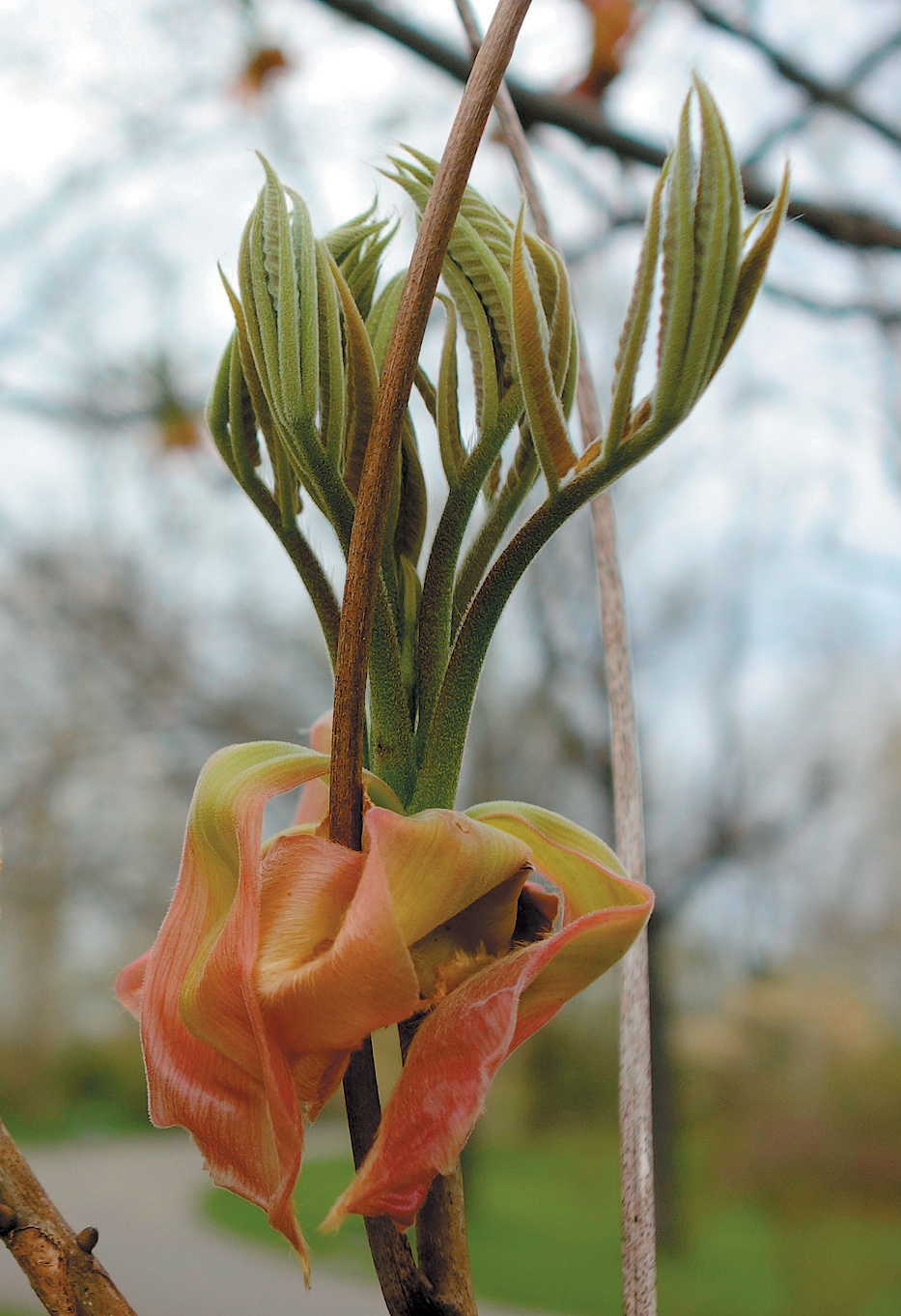

Disjunct genera (Cornus, Hamamelis, Magnolia, Hydrangea sensu lato, Taxus, Diervilla/Weigela, and Viburnum)
The rich evolutionary history shared between the floras of Eastern Asia and North America has also been an important part of the Arnold Arboretum’s history. Although the list of desiderata identifies many genera (including many of those listed above) that are referred to as disjuncts, there are seven genera (Cornus, Hamamelis, Magnolia, Hydrangea sensu lato, Taxus, Diervilla/Weigela, and Viburnum) specifically prioritized for active development because of this distinction. Species representation should remain synoptic (although Hamamelis is already represented at the comprehensive level), with priority based on the axes of conservation status and phylogenetic breadth. Each species should be represented by at least one wild-origin lineage.
Filling in Synoptic and Documentation Gaps
Beyond the focused development of the 17 genera above, many other species must be added to achieve the stated goals. If the Arboretum’s Living Collections are to be considered fully synoptic and representative of Earth’s temperate woody flora, over 175 species and 40 genera not represented will be targeted and acquired. Acquisition of the rare is essential, and the list of desiderata includes over 50 targets with specific conservation value as measured by a NatureServe ranking of G1 to G3 (critically imperiled, imperiled, vulnerable) or its general equivalent.
Documentation is the most reliable predictor of accession value, and many targets were selected to fill documentation gaps. One-fourth of the target taxa on the list are already growing in the Living Collections, yet are represented by accessions that are not of wild origin. It is essential that these “finally wild” targets are integrated into the Living Collections to displace specimens that have poorer (or no) documentation. Another third of the target taxa already exist in the collections and include at least one wild-origin accession. However, additional wild lineages are required to broaden the diversity of that taxon’s lineage pool. An additional one-fourth of the target taxa either have not been tried at the Arboretum in the past, or they were planted but failed to establish because they were not sited in a suitable microclimate or for other reasons. In the spirit of exploration, hardiness testing, and plant introduction, the Arboretum will trial these taxa.
Genomic Type Specimens
Initially, the number of accessions associated with published genomic data will likely number in the single digits. However, with time, improvements in DNA sequencing technology and data analysis will likely yield dozens, if not hundreds of temperate woody plant taxa with sequenced genomes. The Living Collections Advisory Board will be charged with assessing which taxa should be added to the genomic type specimens of the Arboretum. Initially, attention to phylogenetic breadth both within angiosperms and also across seed plants (e.g., conifers and gnetophytes) should be critical. However, with time, opportunities for focused comparative biological studies of genomic type specimens from multiple species (or even populations) within a species/genus/ clade are likely to become important.
Concluding Thoughts
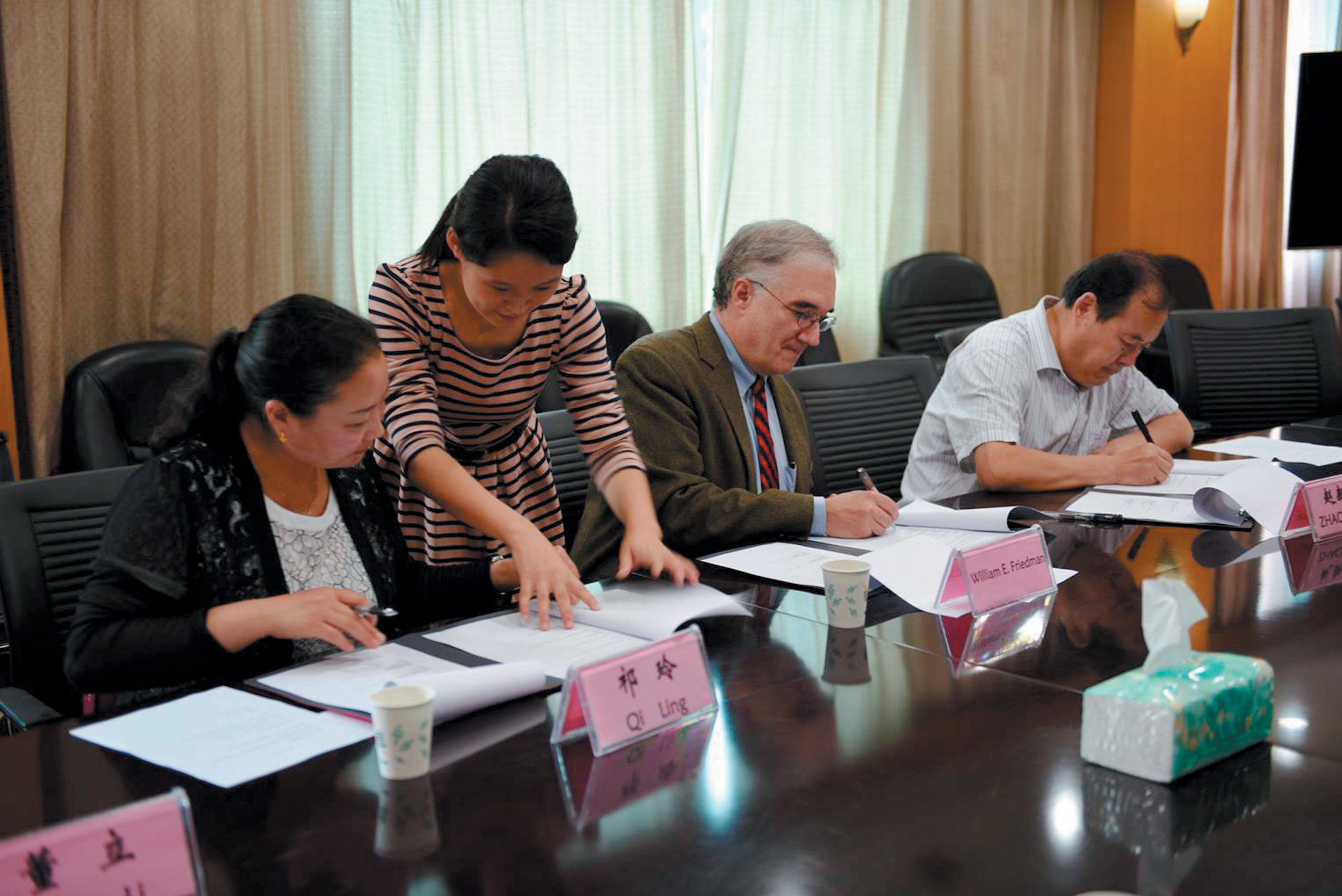
The Campaign for the Living Collections does not just consider the long term, it focuses on it. The 400 taxa to be acquired in the next ten years, including 177 species of woody plants new to the grounds of the Arnold Arboretum, will have a profound impact on the character and value of the living collections. This impact will resonate for decades, if not centuries, to come, just like the vital collections made a century ago by explorers like Sargent, Wilson, Rock, and countless others. The efforts of this decade-long campaign are aimed at renewing and reinventing the Arboretum’s legacy of discovery, natural history, and plant collecting to document, preserve, and study biodiversity in a world dominated by human-induced habitat loss and climate change.
List of Disiderata
| Family | Taxon |
| Actinidiaceae | Actinidia chinensis |
| Adoxaceae | Viburnum atrocyaneum Viburnum bracteatum Viburnum buddleifolium Viburnum carlesii Viburnum cylindricum Viburnum davidii Viburnum ellipticum Viburnum farreri Viburnum foetidum Viburnum ichangense Viburnum kansuense Viburnum lantanoides Viburnum microcarpum Viburnum mongolicum Viburnum obovatum Viburnum plicatum ssp. tomentosum Viburnum sieboldii Viburnum tinus Viburnum urceolatum Viburnum wilsonii |
| Altingiaceae | Liquidambar styraciflua |
| Anacardiaceae | Cotinus szechuanensis |
| Apocynaceae | Asclepias incarnata Trachelospermum difforme |
| Araliaceae | Aralia nudicaulis |
| Araucariaceae | Araucaria araucana |
| Aristolochiaceae | Aristolochia tomentosa |
| Berberidaceae | Nandina domestica |
| Betulaceae | Alnus glutinosa Alnus maritima Betula alleghaniensis Betula alnoides Betula chichibuensis Betula humilis Betula lenta Betula luminifera Betula maximowicziana Betula murrayana Betula pumila Betula schugnanica Betula uber Carpinus caroliniana Carpinus cordata Carpinus coreana Carpinus henryana Carpinus polyneura Ostrya japonica Ostryopsis davidiana |
| Bignoniaceae | Campsis grandiflora |
| Buxaceae | Pachysandra procumbens Pachysandra terminalis Sarcococca hookeriana var. digyna |
| Cactaceae | Opuntia humifusa |
| Cannabaceae | Aphananthe aspera Celtis tenuifolia |
| Caprifoliaceae | Kolkwitzia amabilis Leycesteria formosa Weigela coraeensis Weigela maximowiczii Weigela middendorffiana |
| Celastraceae | Euonymus fortunei Euonymus obovatus |
| Cercidiphyllaceae | Cercidiphyllum magnificum |
| Cloranthaceae | Sarcandra glabra |
| Cornaceae | Alangium platanifolium Aucuba japonica Cornus alternifolia Cornus canadensis Cornus florida Cornus foemina Cornus nuttallii Cornus quinquinervis Cornus rugosa |
| Cupressaceae | Cupressus nootkatensis |
| Cyrillaceae | Cliftonia monophylla |
| Daphniphyllaceae | Daphniphyllum macropodum |
| Elaeagnaceae | Elaeagnus multiflora |
| Ephedraceae | Ephedra distachya Ephedra equisetina Ephedra gerardiana Ephedra intermedia Ephedra likiangensis Ephedra major Ephedra minuta Ephedra monosperma Ephedra przewalskii Ephedra rituensis Ephedra sinica Ephedra viridis |
| Ericaceae | Agarista populifolia Eubotryoides grayana Gaultheria miqueliana Gaultheria procumbens Kalmia cuneata Kalmia latifolia Pieris floribunda Pieris formosa Pieris japonica Rhododendron maximum Rhododendron smirnowii Vaccinium angustifolium Vaccinium macrocarpon |
| Euphorbiaceae | Croton alabamensis |
| Fabaceae | Cercis siliquastrum Cladrastis kentuckea Cladrastis wilsonii Gymnocladus chinensis Maackia hupehensis Robinia hispida |
| Fagaceae | Fagus crenata Fagus engleriana Fagus grandifolia Fagus hayatae Fagus japonica Fagus longipetiolata Fagus lucida Fagus moesiaca Fagus multinervis Fagus orientalis Fagus sylvatica Nothofagus dombeyi Quercus acerifolia Quercus castaneaefolia Quercus falcata Quercus frainetto Quercus gambelii Quercus imbricaria Quercus nigra Quercus prinoides Quercus velutina |
| Ginkgoaceae | Ginkgo biloba |
| Hamamelidaceae | Disanthus cercidifolius Distylium racemosum Fortunearia sinensis Fothergilla gardenii Fothergilla major Hamamelis japonica Hamamelis mollis Hamamelis ovalis Hamamelis vernalis Parrotiopsis jacquemontiana Sinowilsonia henryi Sycopsis sinensis |
| Helwingiaceae | Helwingia japonica |
| Hydrangeaceae | Cardiandra alternifolia Cardiandra moellendorfii Decumaria sinensis Deinanthe bifida Hydrangea macrophylla ‘Ayesha’ Philadelphus lewisii Platycrater arguta |
| Hypericaceae | Hypericum beanii Hypericum buckleyi Hypericum kalmianum Hypericum prolificum |
| Iteaceae | Itea ilicifolia Itea virginica |
| Juglandaceae | Carya aquatica Carya cathayensis Carya cordiformis Carya floridana Carya illinoinensis Carya laciniosa Carya myristiciformis Carya ovata Carya ovata var. australis Carya pallida Carya texana Carya tomentosa Juglans mandshurica Juglans nigra |
| Lamiaceae Monarda didyma Prunella vulgaris | |
| Lardizabalaceae | Decaisnea fargesii |
| Lauraceae | Neolitsea sericea Persea borbonia Sassafras albidum Sassafras tzumu |
| Liliaceae | Lilium regale |
| Lythraceae | Lagerstroemia indica |
| Magnoliaceae | Liriodendron chinense Magnolia acuminata Magnolia denudata var. denudata Magnolia figo Magnolia omeiensis Magnolia patungensis |
| Meliaceae | Cedrela sinensis |
| Menispermaceae | Menispermum canadense Menispermum dauricum |
| Moraceae | Maclura pomifera |
| Nyssaceae | Davidia involucrata Nyssa sinensis |
| 20 | |
| Oleaceae | Chionanthus virginicus Forsythia europaea Forsythia japonica Forsythia mandschurica Forsythia suspensa Forsythia togashii Fraxinus americana Fraxinus nigra Fraxinus pennsylvanica Fraxinus quadrangulata Osmanthus americanus Syringa afganica Syringa emodi Syringa josikaea Syringa julianae Syringa komarowii Syringa komarowii ssp. reflexa Syringa mairei Syringa meyeri Syringa oblata Syringa oblata ssp. dilatata Syringa pinetorum Syringa pinnatifolia Syringa protolaciniata Syringa pubescens ssp. microphylla Syringa reticulata Syringa sweginzowii Syringa tibetica Syringa villosa Syringa vulgaris Syringa wardii Syringa yunnanensis |
| Papaveraceae | Meconopsis integrifolia |
| Pinaceae | Abies alba Abies koreana Larix laricina Larix lyalii Larix occidentalis Larix potaninii Picea abies Picea omorika Pinus albicaulis Pinus cembra Pinus lambertiana Pinus monophylla Pinus virginiana Pseudolarix amabilis Tsuga canadensis Tsuga caroliniana Tsuga chinensis Tsuga diversifolia Tsuga dumosa Tsuga forestii Tsuga formosana Tsuga heterophylla Tsuga mertensiana Tsuga sieboldii |
| Platanaceae | Platanus orientalis Ranunculaceae Clematis akebioides Clematis tangutica Clematis viridis |
| Rhamnaceae | Ziziphus jujuba |
| Rosaceae | Amelanchier nantucketensis Crataegus distincta Crataegus harbisonii Crataegus latebrosa Crataegus perjucunda Crataegus phaenopyrum Cydonia oblonga Exochorda korolkowii Exochorda racemosa Exochorda serratifolia Malus angustifolia Malus coronaria Malus florentina Malus ioensis Malus komarovii Malus prunifolia Malus transitoria Mespilus canescens Neviusia albamensis Physocarpus opulifolius Prunus apetala Prunus cyclamina Prunus maritima Prunus sargentii Rosa chinensis Rosa hugonis Rubus paludivagus Rubus prosper Rubus saltuensis Sorbaria kirilowii Sorbus domestica Sorbus wilsoniana Spiraea sargentiana |
| Rubiaceae | Adina rubella Emmenopterys henryi Mitchella undulata |
| Salicaceae | Populus grandidentata Populus tremuloides Salix jejuna Salix turnorii Santalaceae Buckleya angulosa Buckleya distichophylla Buckleya graebneriana Buckleya henryi Buckleya lanceolate |
| Sapindaceae | Acer argutum Acer buergerianum Acer caesium Acer campbellii Acer capillipes Acer cappadocicum Acer cappadocicum ssp. divergens Acer cappadocicum ssp. lobelii Acer caudatum Acer ceriferum Acer circinatum Acer cordatum Acer davidii ssp. grosseri Acer diabolicum Acer distylum Acer erianthum Acer fabri Acer fulvescens Acer glabrum Acer gracilifolium Acer griseum Acer heldreichii Acer henryi Acer hyrcanum Acer leipoense Acer longipes Acer lungshengense Acer macrophyllum Acer maximowiczianum Acer miyabei Acer mono ssp. okamotoanum Acer nipponicum Acer oblongum Acer oliverianum Acer opalus Acer pilosum Acer platanoides Acer pseudoplatanus Acer pubipalmatum Acer pycnanthum Acer robustum Acer rubrum Acer sempervirens Acer shirasawanum Acer sieboldianum Acer stachyophyllum Acer sutchuensense Acer tataricum ssp. aidzuense Acer tataricum ssp. semenovii Acer tenellum Acer truncatum Acer tschonoskii Acer tsinglingense Dipteronia sinensis |
| Schisandraceae | Kadsura heteroclite Kadsura japonica Schisandra glabra |
| Sciadopityaceae | Sciadopitys verticillata |
| Simaroubaceae | Leitneria floridana |
| Stachyuraceae | Stachyurus chinensis |
| Styracaceae | Halesia macgregorii Sinojackia henryi Sinojackia xylocarpa Styrax americanus Styrax grandifolius |
| Tamaricaceae | Tamarix ramosissima |
| Taxaceae | Taxus brevifolia Taxus wallichiana var. chinensis Taxus wallichiana var. mairei Torreya nucifera |
| Tetracentronaceae | Tetracentron sinensis |
| Theaceae | Gordonia lasianthus Schima wallichii Stewartia malacodendron Stewartia monadelpha Stewartia ovata Stewartia pseudocamellia Stewartia rubiginosa Stewartia serrata Stewartia sinensis |
| Thymeliaceae | Daphne genkwa Daphne mezereum Daphne tangutica Dirca decipiens |
| Tiliaceae | Tilia henryana Tilia kiusiana |
| Ulmaceae | Planera aquatica Ulmus alata Ulmaceae Ulmus laevis Ulmus macrocarpa Ulmus rubra Zelkova carpinifolia Zelkova serrata |
| Verbenaceae | Callicarpa americana Callicarpa bodinieri |
Sidebar | Plant Phylogeny
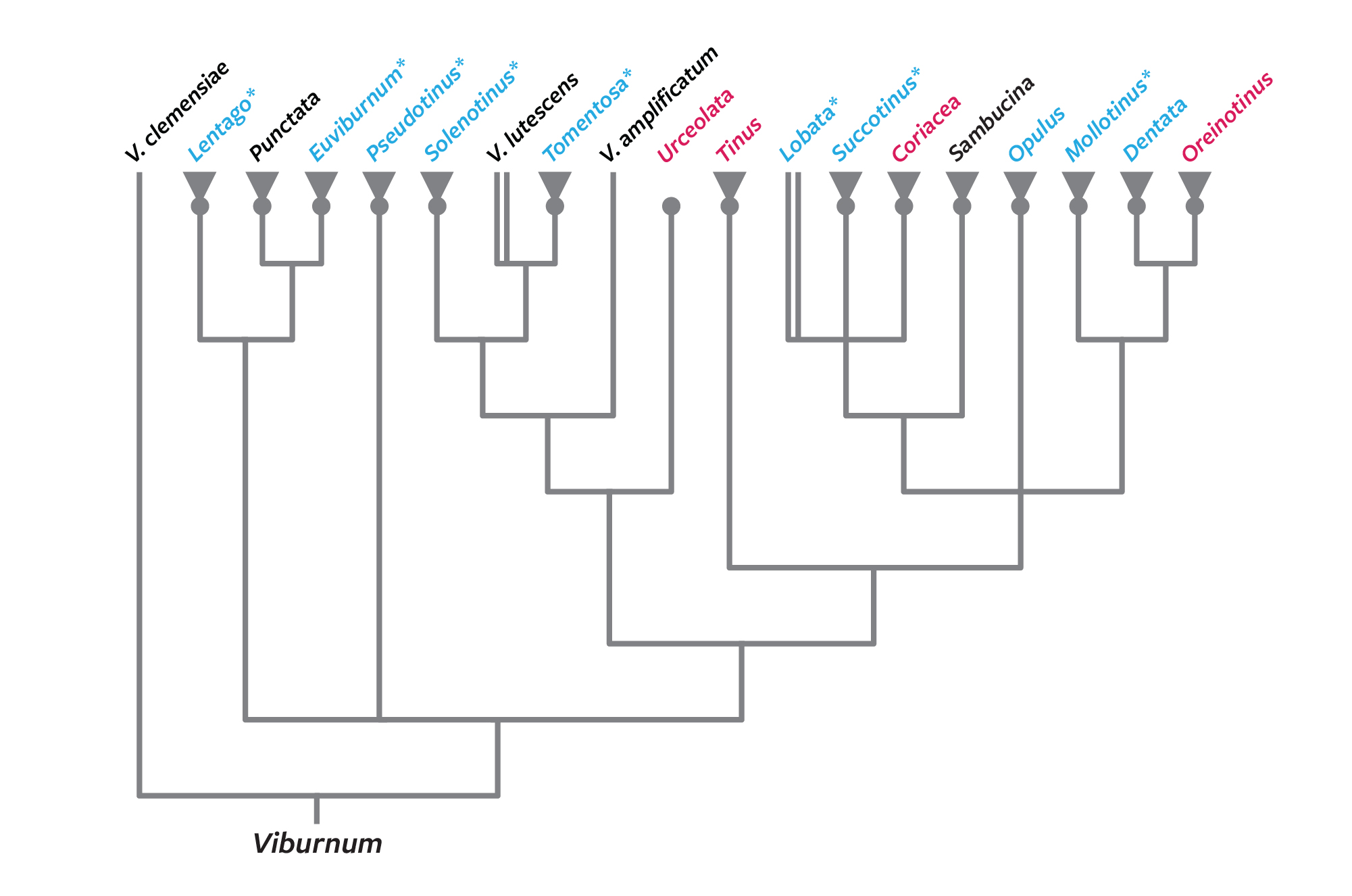
When explaining the relatedness of organisms, scientists often construct a phylogeny, or “family tree,” that portrays the organisms’ evolutionary history. This figure depicts taxa (such as species, genera, families, etc.) on the tips or ends of the branches. Each taxon placed at the end of a branch is paired with its closest relative; the two can be traced back to a shared node that represents their common ancestor. That branch, in turn, can be traced back further to another ancestor that is common to it and another “sister” branch, ad infinitum. A branch that includes the common ancestor and all of its descendants is referred to as a clade. In contemporary phylogenetic systematics, a plant family’s phylogeny should comprise individual clades of species that form distinct genera. Genera themselves comprise clades of species that share a common ancestor, and may receive special names.
Organizing related species into clades is useful when studying large genera and families, particularly if the group is supported by a well-developed and accepted phylogeny. In such cases scientists look at all of the clades that occur across the breadth of the phylogeny but only need to sample one or two species per clade. We have taken the same approach to collections development at the Arboretum, where comprehensive or total species composition within a genus is not a goal but phylogenetic breadth (i.e., representation of as many clades as possible) is.
The genus Viburnum (comprising some 165 species) is one such example. Decades of work in Michael Donoghue’s laboratory has yielded a well-supported Viburnum phylogeny containing 19 terminal clades of closely related species (above, modified from Clement et al. 2014). Ten of these clades (shown in blue) are already represented in the Arboretum’s collections by at least one species; acquisition of a few more species (*) improves their representation. Although the remaining clades contain species not suited to New England (most are tropical), four clades (shown in red) contain a few marginally-hardy species that are worth trialing. Adding even just one species from a clade (e.g., V. davidii in the Tinus Clade) adds a completely new evolutionary lineage to the collections.
Sidebar | Genome Sequencing Brings New Knowledge
Genome sequencing, which allows the entire string of DNA code to be read and interpreted for almost any species on earth, has the potential to link specific biological characteristics to specific genes and their genetic variants. Fifteen years ago, it cost nearly $100 million to sequence a genome and today, this cost is rapidly approaching $1,000. Thus, in the last decade, woody plant species as diverse as grape, poplar, pine, willow, oak, and birch have had their genomes sequenced, so that their biological traits can be related directly to their genes. Many more species of trees, shrubs, and lianas are in the pipeline for genomic sequencing.
In the spring of 2015, the Arnold Arboretum hosted an international symposium on the genomics of forests and trees that brought together 80 of the leading scholars in this emerging world of DNA information. One critical challenge that came up repeatedly in discussions with participants is that those organisms whose genomes have been or are going to be sequenced are at high risk of being lost since there is no formal plan for perpetual stewardship. Incredibly, there is no home in the entire world for the unique individual plants whose genomes have been sequenced.
The Arnold Arboretum has a perfect combination of world-class horticulture and world-class laboratory facilities to pioneer a “genomic type collection” of temperate woody plants, and will care in perpetuity for these incredibly special individual plants whose genomes have been sequenced. This genomic type reference collection will help tell us how trees will respond to climate change, how water moves from the soil to the top of the crown, how plants respond to biotic (herbivores) and abiotic (climate extremes) stresses. As research comes to rely more heavily on sequenced genes to advance discovery, the ability to reference the living counterpart of this DNA—either through the plant itself or its direct lineage—will make the Arnold Arboretum an essential resource for this work.
Citation: Friedman, W. E., Dosmann, M. S., Boland, T. M., Boufford, D. E., Donoghue, M. J., Gapinski, A., Hufford, L., Meyer, P. W., and Pfister, D. H. 2016. Developing an exemplary collection: A vision for the next century at the Arnold Arboretum of Harvard University. Arnoldia, 73(3): 2–18.
William E. Friedman is Director of the Arnold Arboretum and Arnold Professor of Organismic and Evolutionary Biology at Harvard University; Michael S. Dosmann is Curator of Living Collections at the Arnold Arboretum; Timothy M. Boland is Executive Director of Polly Hill Arboretum; David E. Boufford is Senior Research Scientist at the Harvard University Herbaria; Michael J. Donoghue is Curator of Botany at the Peabody Museum and Sterling Professor of Ecology and Evolutionary Biology at Yale University; Andrew Gapinski is Manager of Horticulture at the Arnold Arboretum; Larry Hufford is Professor and Director of the School of Biological Sciences and Director of the Marion Ownbey Herbarium at Washington State University; Paul W. Meyer is F. Otto Haas Executive Director of the Morris Arboretum of the University of Pennsylvania; and Donald H. Pfister is Curator of the Farlow Library and Herbarium and Asa Gray Professor of Systematic Botany at Harvard University.
From “free” to “friend”…
Established in 1911 as the Bulletin of Popular Information, Arnoldia has long been a definitive forum for conversations about temperate woody plants and their landscapes. In 2022, we rolled out a new vision for the magazine as a vigorous forum for tales of plant exploration, behind-the-scenes glimpses of botanical research, and deep dives into the history of gardens, landscapes, and science. The new Arnoldia includes poetry, visual art, and literary essays, following the human imagination wherever it entangles with trees.
It takes resources to gather and nurture these new voices, and we depend on the support of our member-subscribers to make it possible. But membership means more: by becoming a member of the Arnold Arboretum, you help to keep our collection vibrant and our research and educational mission active. Through the pages of Arnoldia, you can take part in the life of this free-to-all landscape whether you live next door or an ocean away.







